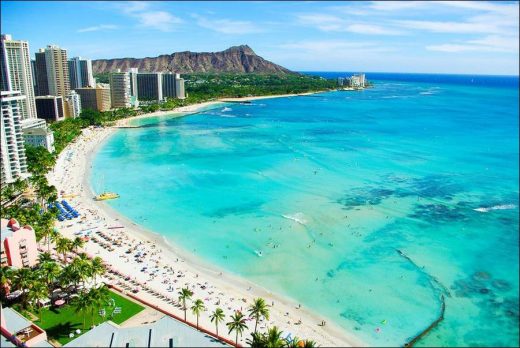What to know before you make summer vacation plans.
Travel in the coronavirus age. Spring break, save for some determined spring breakers in Florida and tourists heading to Hawaii, was largely canceled, but what about summer vacation? Will it be safe — and acceptable — to travel come June and July? And is now a good time to start planning summer travel?
With so much uncertainty still around the pandemic and the world’s ability to curb the virus’ spread, there’s no clear cut answer to these questions. With international borders snapping shut, airlines grounding thousands of flights around the globe and health officials everywhere pleading for people to stay home to slow the spread of COVID-19, traveling anywhere beyond your local grocery store may have serious repercussions.
Canadian Teresa Banner and her family have a trip booked to Europe in mid-May. “I have spent maybe 50 hours planning this trip,” she told CNN Travel. “Leading up to a week ago I was thinking it should be fine. Then for the last five days I thought, no, it’s canceled for sure. Just in the last two days I think it might be OK. I really am all over the place.”
Banner is not the only one who has been wondering about travel plans down the line. Just ask an Olympian. For weeks, athletes were kept on the edge. Will Tokyo continue the Games as planned for July 2020? At least for them and people planning to attend, they got an answer on Wednesday: the Olympic Games are being moved back a year to 2021.
The Happiest Place on Earth, Disneyland, has closed its properties until at least the end of March. The organization has automatically canceled and refunded reservations until then. As for April and beyond, Disney websites say only they are “in regular contact with appropriate officials and health experts.”
The US Department of State advises simply: “do not travel” and refers people to the Centers for Disease Control and Prevention (CDC) for more information.
While the CDC has a map showing the level of risk around the world, it doesn’t have a clear timeline for when travel may be safe.
“Different countries can be in different phases of the pandemic at any point in time and different parts of the same country can also be in different phases of a pandemic,” the CDC writes. “There are ongoing investigations to learn more. This is a rapidly evolving situation and information will be updated as it becomes available.”

Status of restrictions lifting? TBD
As the border between Canada and the United States closes to all but essential traffic this week, Canadian Prime Minister Justin Trudeau said travel restrictions and other measures to slow the pandemic could continue for “weeks to months.”
Trudeau made the comments from the front step of his house in Ottawa on Thursday, where he and his family are in self-isolation after his wife, Sophie Grégoire Trudeau, tested positive for COVID-19 after returning from the UK.
But some public health researchers are suggesting travel restrictions will last much longer than a few months. “Things are going to be very difficult for 12 months or more,” Penn State epidemiologist Maciej Boni told CNN Travel.
In a piece in the Conversation, a network of not-for-profit media outlets that publish news stories written by academics and researchers, Boni suggests there will be a year of disruption.
“Vacations may have to be canceled. Social interactions will look different. And risk management is something we’re going to have to think about every morning when we wake up,” he writes.
The decision about whether you can safely venture out of the house, never mind the country, will come when we’ve managed to “stamp out transmission” of COVID-19, says Kumi Smith, an assistant professor of epidemiology at the University of Minnesota.
At this stage, she told CNN Travel, no one can say when that might be. “The predictive mathematical models are being built, and the whole point of that is to try to give lawmakers, authorities and public health officials some grasp of what’s going on. But as new cases come in, that new data is being fed into the models; it’s updated every day.”
The models change depending on how the public responds to the restrictions: The less we go to the beach and the more we follow advice to wash our hands frequently, cough and sneeze into our elbows and practice social distancing, the better those mathematical models will look.
Research now, plan later
“When it comes to ‘When will this all end and when can I travel again’?” I would push that question back,” says Smith. “I’d say it’s on us to adhere to these regulations and to quarantine ourselves and monitor ourselves and try to do what we can as individuals to stop this from spreading.”
As for her summer vacation, she’s not making any plans.
“I don’t really want the emotional roller coaster of planning a really exciting summer trip and then not being able to go on it.”
If you to decide to jump on that roller coaster and start planning a summer trip, you’ll want to check out all the fine print about changes and cancellations.
Meanwhile, travel professionals suggest this is the perfect time to research your next trip. “For now, let’s take time to wanderlust, to virtually explore, to deep dive into destinations and to dream where’s next,” says Amanda Hills, the president of Hills Balfour, a PR agency in London that represents dozens of international destinations and hotels.
“Soon enough, borders will once again be open and barriers lifted.” In the meantime, Hills suggests spending time enjoying “armchair adventures” such as virtual walking tours through the Grand Canyon or live streaming opera from Vienna.
Teresa Banner is still hoping she can go to Europe in May. “The nature of the whole situation is we don’t know. It’s 50% yes, 50% no. Nobody knows. I’m not even worrying about it. I’m just getting stuff done around the house.”
Views: 608



